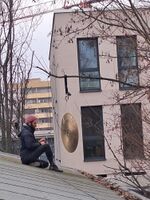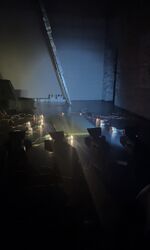Capturing and processing vibrations: Difference between revisions
| (4 intermediate revisions by 2 users not shown) | |||
| Line 1: | Line 1: | ||
[[category: Research]] |
[[category: Research]] |
||
[[File:PaulGong.jpg|right|150px|border|Paul and the gong]] |
|||
[[File:Sequence1.jpg|right|150px|border|]] |
|||
==Context== |
==Context== |
||
Starting from choreographer Anne Juren's work Sensorial Transference, Anne Juren, Paul Kotal (sound designer) and Bruno Pocheron (lighting designer) came together in Tanzhalle Wiesenburg in January 2023 for a ten days residency focused on interfacing with vibrations inherent to objects and rooms, addressing the relation between inside and outside spaces . Marc Lagies (programmer) and Marcello Silvio Busato (musician) contributed to that research. |
Starting from choreographer Anne Juren's work Sensorial Transference, Anne Juren, Paul Kotal (sound designer) and Bruno Pocheron (lighting designer) came together in Tanzhalle Wiesenburg in January 2023 for a ten days residency focused on interfacing with vibrations inherent to objects and rooms, addressing the relation between inside and outside spaces . Marc Lagies (programmer) and Marcello Silvio Busato (musician) contributed to that research. |
||
https://www.researchcatalogue.net/profile/show-exposition?exposition=1395394 |
|||
==Initial concepts== |
==Initial concepts== |
||
| Line 33: | Line 38: | ||
Sound treatment applied to the |
Sound treatment applied to the inputs of the singing bowl: |
||
* a set of heavy compression with a fairly fast attack to smooth out the inherent tremolo |
* a set of heavy compression with a fairly fast attack to smooth out the inherent tremolo |
||
Latest revision as of 20:57, 25 January 2023
Context
Starting from choreographer Anne Juren's work Sensorial Transference, Anne Juren, Paul Kotal (sound designer) and Bruno Pocheron (lighting designer) came together in Tanzhalle Wiesenburg in January 2023 for a ten days residency focused on interfacing with vibrations inherent to objects and rooms, addressing the relation between inside and outside spaces . Marc Lagies (programmer) and Marcello Silvio Busato (musician) contributed to that research.
https://www.researchcatalogue.net/profile/show-exposition?exposition=1395394
Initial concepts
In Sensorial Transference we used the term of trans-corporealities, which refers to the ways bodies are interconnected and influenced by each other in a co-regulated way. That phenomenon often happens during a soma-therapeutic treatment. For example the heart beats of the patient and the practitioner start synchronising during a session.
We were interested in exploring how those interconnections can also be applied to spaces and objects, which are affected by their environment (the outside) and the resonance of the materials they are made of (the inside). For that we focused on the notion of vibration within and beyond the audible and visible ranges, and tried out electro-mechanical ways of creating an artificial trans-corporeality between objects and spaces. A similar approach can be found e.g. in the works of Bill Fontana. https://ars.electronica.art/planetb/de/silent-echoes-notre-dame/
We set up to expand these interconnections over time and to relocate them in media specific to our practices.
Set up / Implementation
We concentrated on metallic objects such as a gong, fire bowls and singing bowls for their properties of capturing, filtering and transposing/transporting vibrations in the audible domain. We also treated the whole space of Tanzhalle Wiesenburg as a resonating body. For now we used piezo sensors and microphones to capture vibrations, transducers and speakers to amplify and displace them, incandescent lighting bulbs and LED fixtures to translate them in the visible spectrum.
In our experimental set up we used mainly two objects as sound inputs:
- a gong placed on the roof of the studio equipped with a piezo sensor, capturing the sonic environment (trains from afar, birds, sirens, conversations of neighbours, kids playing, church bells, a wedding cortege, etc.)
- a singing bowl placed in the room equipped with a dynamic microphone and played as an instrument
Sound treatment applied to the input from the gong:
- eQing in order to clean the signal of parasite noise and to compensate for overly present resonances
- heavy compression to enhance the atmospheric sounds and avoid clipping
- transient shaping to extend the natural sustain of the gong
- noise reduction
Sound treatment applied to the inputs of the singing bowl:
- a set of heavy compression with a fairly fast attack to smooth out the inherent tremolo
- a steep lowCut filter at 200 Hz to protect the incandescent lighting bulbs
- 3 tremolos tuned to the tempo/wavelength of the inherent frequencies. Resulting in a 1/4 note tremolo for the root note, a 1/8 tremolo for the first harmonic and a 1/16 note tremolo for the second harmonic at a tempo of 90.90 bpm
- those tremolos were inserted on separated mixer buses with eQs tuned to the frequency spectrum of the root note and the two upper harmonics
The vibrations sonically treated as described above were then sent to various outputs:
- a big shelf made to sound by a bass transducer
- a fire bowl made to sound by a bass transducer
- a window made to sound by a full range transducer
- a stereo pair of studio monitors
- two series of low voltage lighting bulbs powered by a stereo sound amplifier
- the color and intensity channels of 3 LED Fresnel fixtures
Sound input applied to the control of the color mix of the LED fixtures:
- The 3 tremolos are sent to 3 inputs of a sound interface
- Their envelope is analysed and re-scaled to a range of values fitting the DMX protocole in the lighting instance of Pure Data
- These values, sent via UDP to a Lanbox DMX controller, are then used to control the color mix of each of the 3 Fresnel fixtures
Sound input applied to the control of the intensity channel of the LED fixtures:
- A 4th input of the sound interface receives the processed audio signal from the live input of the singing bowl, resulting in a decay
- Its envelope is similarly analysed and re-scaled in the lighting instance of Pure Data
- it sent via UDP to the Lanbox DMX controller and used to control the intensity channels of the 3 Fresnel fixtures
Additionally:
- we used the intensity of the LED lighting fixtures to modify the tonal spectrum of resonating objects and the decay time of their resonances
- we also used the intensity of the LED lighting fixtures, sent via UDP and OSC to the sound instance of Pure Data, to control the intensity of the 3 tremolos
Creation of a sequence
We finally created a short sequence based on the notion of expansion of interconnections over time and relocation of processed signal in various media:
- the live input of the gong on the roof was played back to the shelf, the fire bowl and the studio monitors. In this instance the volume of the fire bowl followed the intensity of the LED Fresnels, that also influenced its tonal spectrum. At the same time the volume of the shelf was influenced by the inverted values of the intensity of the LED Fresnels, resulting in counter movement in volume
- the singing bowl was played acoustically as an instrument. Its resonances were picked up by the dynamic microphone, delayed by 20 seconds and sent to the low voltage lighting bulbs that flared in sync with the two upper tremolos of the singing bowl. After an other delay of 50 seconds the same signal was sent to the LED Fresnels that displayed in color tones and intensity the three tremolos and the envelope of the signal
- the resonances of the singing bowl were also sent to the fire bowl when sent first to the bulbs and then to the Fresnels. Only this second event was affecting the spectral modification of the resonances audible from the fire bowl
- by playing the singing bowl in different ways, different reactions of the bulbs and the Fresnels were controlled

